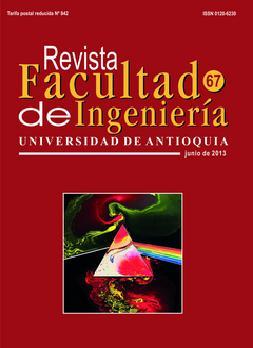Synthesis of two new Nickel and CopperNickel vanadates used for propane oxidative dehydrogenation
DOI:
https://doi.org/10.17533/udea.redin.16317Keywords:
nickel vanadate, copper-nickel vanadate, propane, propene, oxidative dehydrogenationAbstract
Two new vanadates have been successfully synthesized by the hydrothermal and coprecipitation methods. Both vanadates were calcined at 600 °C and the resulting catalysts were tested on reaction of oxidative dehydrogenation of propane. The catalysts were characterized by x-ray diffraction, atomic absorption, thermogravimetric analysis, and differential temperature analysis. The reaction was carried out in the temperature range of 350-500 °C. A conversion of propane of 10.6 % and a selectivity towards propene of 29.9 % at 400 °C were obtained with nickel vanadate; a conversion of 1.9 % and a selectivity of 56.9 % were reached at the same temperature with the nickel copper vanadate.
Downloads
References
F. Cavani, N. Ballarini, A. Cericola. “Oxidative dehydrogenation of ethane and propane: How far from commercial implementation?”. Catal. Today. Vol. 127. 2007. pp. 113-131. DOI: https://doi.org/10.1016/j.cattod.2007.05.009
H. Kung, M. Chaar. “Oxidative Dehydrogenation of Alkanes to Unsaturated Hydrocarbons”. U.S. Patent N.° 4,777,319. January 01. 1988.
U. Ozkan, R. Watson. “Preparation and use of a catalyst for the oxidative dehydrogenation of lower alkanes”. U.S. Patent N. ° 6,521,808. Februrary 18. 2003.
L. Levels, S. Fuchs, K. Seshan, J. Lercher, L. Lefferts. “Oxidative conversion of light alkanes to olefins over alkali promoted oxide catalysts”. Appl. Catal. A. Vol. 227. 2002. pp. 287-297. DOI: https://doi.org/10.1016/S0926-860X(01)00944-9
L. Leveles, K. Seshan, J. lercher, L. Lefferts. “Oxidative conversion of propane over lithium-promoted magnesia catalyst - I. Kinetics and mechanism”. J. Catal. Vol. 218. 2003. pp. 296-306. DOI: https://doi.org/10.1016/S0021-9517(03)00112-X
L. Madeira, M. Portela, C. Mazzocchia. “Nickel molybdenum catalysts and their use in the selective oxidation of hydrocarbons”. Catal. Rev. Vol. 46. 2004. pp. 53-110. DOI: https://doi.org/10.1081/CR-120030053
E. Heracleous, M. Machli, A. Angeliki. “Oxidative dehydrogenation of ethane and propane over vanadium and molybdenum supported catalysts”. J. Mol. Catal. A. Vol. 232. 2005. pp. 29-39. DOI: https://doi.org/10.1016/j.molcata.2005.01.027
S. Sugiyama, T. Hashimoto, N. Shigemoto, H. Hayashi, “Redox Behaviors of Magnesium Vanadate Catalysts During the Oxidative Dehydrogenation of Propane”. Catal. Lett. Vol. 89. 2003. pp. 229-233. DOI: https://doi.org/10.1023/A:1025758614040
S. Sugiyama, T. Hashimoto, Y. Morishita, N. Shigemoto, H. Hayashi. “Effects of calcium cations incorporated into magnesium vanadate on the redox behaviors and the catalytic activities for the oxidative dehydrogenation of propane”. Appl. Catal. A. Vol. 270. 2004. pp. 253-260. DOI: https://doi.org/10.1016/j.apcata.2004.05.018
S. Sugiyama, T. Hashimoto, Y. Tanabe, N. Shigemoto, H. Hayashi. “Effects of the enhancement of the abstraction of lattice oxygen from magnesium vanadate incorporated with copper(II) cations on the oxidative dehydrogenation of propane”. J. Mol. Catal. A: Chem. Vol. 227. 2005. pp. 255-261. DOI: https://doi.org/10.1016/j.molcata.2004.10.046
S. Sugiyama, T. Osaka, Y. Hirata, K. Sotowa. “Enhancement of the activity for oxidative dehydrogenation of propane on calcium hydroxyapatite substituted with vanadate”. Appl. Catal. A. Vol. 312. 2006. pp. 52-58. DOI: https://doi.org/10.1016/j.apcata.2006.06.018
R. Valenzuela, V. Cortes. “On the intrinsic activity of vanadium centers in the oxidative dehydrogenation of propane over V-Ca-O and V-Mg-O catalysts”. Topics in Catal. Vol. 11-12. 2000. pp. 153-160.
S. Sugiyama, T. Osaka, T. Hashimoto, K. Sotowa. “Oxidative Dehydrogenation of Propane on Calcium Hydroxyapatites Partially Substituted with Vanadate”. Catal. Lett. Vol. 103. 2005. pp. 121-123. DOI: https://doi.org/10.1007/s10562-005-6513-7
B. Zhaorigetua, W. Lib, H. Xub, R. Kiefferc. “Correlation Between the Characteristics and Catalytic Performance of Ni–V–O Catalysts in Oxidative Dehydrogenation of Propane”. Catal. Lett. Vol. 94. 2004. pp. 125-129. DOI: https://doi.org/10.1023/B:CATL.0000019342.03708.f3
L. Palacio. “Métodos de síntesis de nuevos materiales basados en metales de transición”. Rev. Fac. Ing. No. 22. 2004. pp. 51-61.
M. Khaled, B. Bouzid, A. Yahya. “Room temperature synthesis of zinc pyrovanadate Zn3 (OH)2 V2 O7 ·2H2 O”. J. Mater. Chem. Vol. 9. 1999. pp. 1543-1545. DOI: https://doi.org/10.1039/a901580i
D. Hoyos, A. Echavarría, C. Saldarriaga. “Synthesis and structure of a porous zinc vanadate, Zn3 (VO4 )2 ·3H2 O”. J. Mater. Sci. Vol. 36. 2001. pp. 5515-5518. DOI: https://doi.org/10.1023/A:1012418706071
L. Palacio, J. Silva, F. Ribeiro, M. Ribeiro. “Catalytic oxidation of volatile organic compounds with a new precursor type copper vanadate”. Catal. Today. Vol. 133. 2008. pp. 502-508. DOI: https://doi.org/10.1016/j.cattod.2007.12.015
F. Zhang, P. Zavalij, M. Whittingham. “Synthesis and characterization of a pipe-structure manganese vanadium oxide by hydrothermal reaction”. J. Mater. Chem. Vol. 9. 1999. pp. 3137- 3140. DOI: https://doi.org/10.1039/a907465a
Downloads
Published
How to Cite
Issue
Section
License
Copyright (c) 2018 Revista Facultad de Ingeniería

This work is licensed under a Creative Commons Attribution-NonCommercial-ShareAlike 4.0 International License.
Revista Facultad de Ingeniería, Universidad de Antioquia is licensed under the Creative Commons Attribution BY-NC-SA 4.0 license. https://creativecommons.org/licenses/by-nc-sa/4.0/deed.en
You are free to:
Share — copy and redistribute the material in any medium or format
Adapt — remix, transform, and build upon the material
Under the following terms:
Attribution — You must give appropriate credit, provide a link to the license, and indicate if changes were made. You may do so in any reasonable manner, but not in any way that suggests the licensor endorses you or your use.
NonCommercial — You may not use the material for commercial purposes.
ShareAlike — If you remix, transform, or build upon the material, you must distribute your contributions under the same license as the original.
The material published in the journal can be distributed, copied and exhibited by third parties if the respective credits are given to the journal. No commercial benefit can be obtained and derivative works must be under the same license terms as the original work.










 Twitter
Twitter